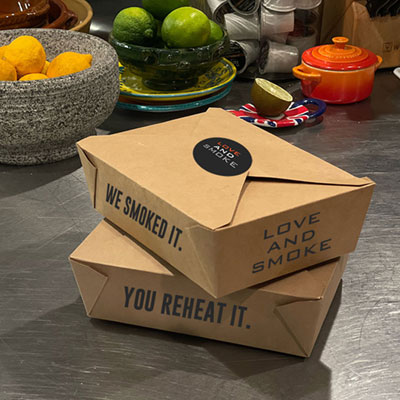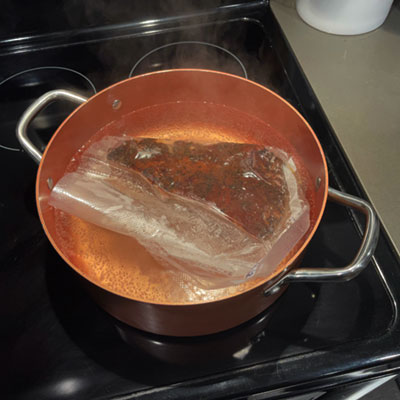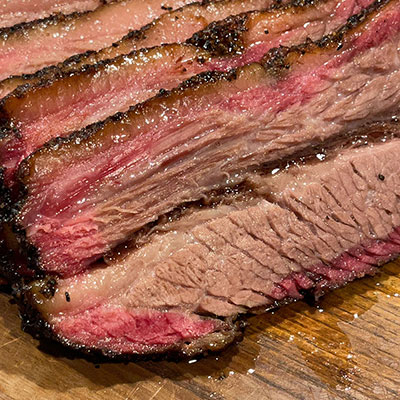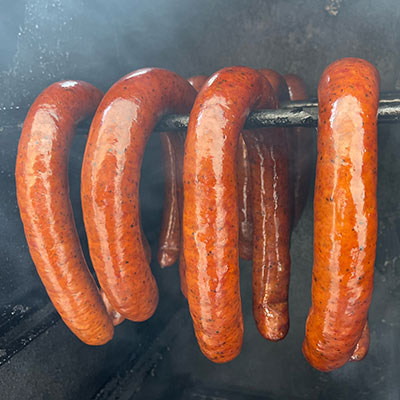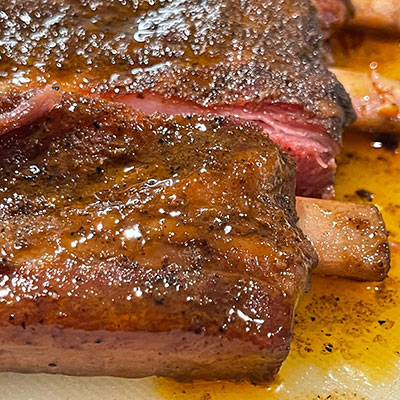
An explanation of our vacuum-seal process for preserving smoked meat quality, providing convenience, and preserving safety. We think you’re going to love the quality and convenience – and we’ll discuss the similarities and differences from true “sous-vide” cooking!

Well, it kinda is, but it really isn’t. The phrase “sous vide” (pronounced “soo veed”), which means “under vacuum” in French, refers to the process of vacuum-sealing food in a bag, then cooking it to a very precise temperature in a water bath. And that’s not exactly what we’re doing here, although the process is similar. True “sous vide” cooking is exactly that – COOKING the vacuum-sealed food at a precise – and relatively low – temperature over a longer period of time. High-end restaurants have been using sous vide cooking for years to cook food to the exact level of doneness desired, every time. It’s not a good solution for all meats – some need the browning process that sous vide avoids yet is necessary for great char-grilled flavor – but without the sous vide process for the types of foods where it is appropriate, it would be much harder for these restaurants to maintain a standard of quality when cooking in large volumes.
In our case, we’re using a vacuum-sealed bag of course, but instead for reheating the already cooked meat (smoked in this case) in water at a higher temperature over a much shorter period of time. But whatever you want to call it, the results really are fantastic.
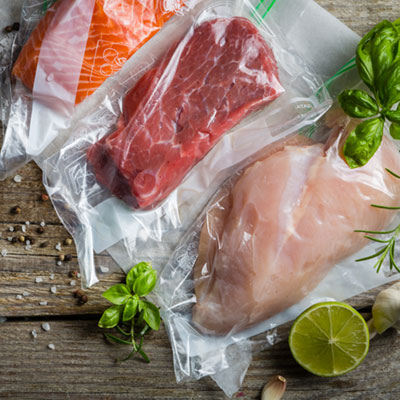
Quite frankly, because of the air we breathe. Air is the enemy of quality smoked barbecue that doesn’t rely on added sauce to create a desirable flavor and experience. Even if you successfully cook a moist and juicy smoked product, it doesn’t take long before exposure to open air starts to dry it out. It’s not as much of an issue when you’re eating smoked meats fresh out of the smoker, but another thing altogether when that meat has to travel for awhile before being consumed. It’s one of the reasons why BBQ restaurants have tended to wrap to-go finished meat in aluminum foil (or even plastic wrap, in the case of one Michelin-starred place we visited) before sending it on its way – partly to retain heat, and partly to keep it from drying out.
So, what happens if that meat has cooled down and you want to reheat it? Once again, it’s the main reason why pickup orders – especially separate meat orders like whole rib racks – have left their establishments fully wrapped in aluminum foil. Partly to keep them warm for as long as possible, partly to keep them from drying out, partly to keep them from losing their valuable juices, and ultimately to provide an efficient way for the meat to be reheated at their destination. When we originally started to sell a la carte meat orders out of our catering kitchen years ago on Thursdays, we discovered that most of our customers weren’t eating the meat right away, but were instead refrigerating it in order to consume it on the upcoming weekend, or even later. That meant reheating the refrigerated smoked meat in that aluminum foil wrap for about an hour in a 300-degree oven. Although the results were pretty good, it wasn’t optimal for the following reasons:
Even though the foil kept most of the juice inside, it’s fairly leak-prone (even heavy-duty aluminum foil is easily punctured by sharp rib bones), and even though foil can be wrapped fairly closely to the meat, it’s still not airtight, which shortens the shelf life of the cooked meat, and prevents it from being frozen properly. (More on that in a minute.) And after being refrigerated, it’s difficult to have the meat’s juicy goodness reconstitute into the meat itself, a process that can happen much better with vacuuum-seal. Ultimately, sending the customers home with aluminum foil-wrapped meat is messy and wasteful. (Although foil is still critical in some smoking processes, proprietors tend to transfer their finished product to a fresh clean wrap of aluminum foil before delivering it to the customer.) Just as important, vacuum-sealing the meats increases their shelf life dramatically, makes for a much more efficient and quick reheating process at home, and most important of all, facilitates a high-quality re-heat result. (We think some finished products actually turn out better after being vacuum-sealed than they were when they came off the smoker. Smoked chickens in particular, whose skin can suffer from the process. Some barbecue cooks go to great lengths to make the skin more “crispy” and less “rubbery” in nature. But we’ve found that the vacuum-seal and reheat process actually intensifies the smoked flavor of the chicken itself, and tends to caramelize the skin into a downright delicacy. We’re creating a video for YouTube and TikTok that will illustrate the process.)
Vacuum-sealing also open up the possibility of being able to properly freeze smoked meats when necessary without suffering freezer burn and/or poor reheating results from using air-retaining freezer bags or aluminum foil, and after thawing it properly (usually for a day in the refrigerator), providing for the same high-quality reheated result as reheating from normal vacuum-sealed refrigeration. We’ve tested the freezing process with smoked beef brisket, smoked pork ribs, and smoked chickens by freezing the meats for four months, then thawing and reheating, and the result was still like the meat just came off the smoker! The juicy pork spare ribs pictured at the bottom of this page were part of that test, and were some of the best ribs we’ve ever served! When a customer’s spouse who normally does most of the cooking in their household suffered an injury that kept them from their cooking activity for awhile, they froze a batch of our smoked meat products to be able to gradually thaw and reheat the meat for meals over an extended period, and they were amazed at not only how convenient the process was, but also how good the results were. Being able to successfully refrigerate AND freeze smoked meats with the end result of having a quality reheated result is a real game-changer for our customers.
The PDF document at this link is an electronic version of the quick-guide that comes with all our vacuum-sealed products, but the process is very simple, and basically works like this:
– Use a saucepan or pot (with an accompanying lid) that is at least as wide as the meat in the vacuum-sealed package itself.
– Place the pack(s) in the pot with enough water to cover it/them, and turn the heat on high.
– When the water starts to reach a slow boil (190F degrees – use a meat thermometer if you have one available), turn the heat down to simmer, and replace the lid.
– A pack of up to 2 lb of meat will only need to simmer about 15 minutes for the meat to reach the proper serving temperature of 155-165 degrees. A larger pot with 5 lb of meat in multiple bags will need 25 minutes to reach the same state. Do not rapidly boil the water, a low simmer will do the job. You’re not COOKING the meat, you’re just reheating it to the proper temperature for serving and safety!
– When the time is up, safely remove the bag(s) from the water, cut open the bags, remove the meat and any accompanying juice, slice if necessary, and serve!
That’s all there is to it! We hope our customers enjoy the added convenience and retained quality of our smoked meat products when delivered in this manner. We love serving our food to you hot and fresh directly, but this method allows us to create the same results for you at home!
